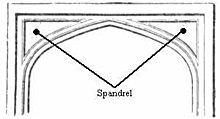spandrel
Jump to navigation
Jump to search
English[edit]

Alternative forms[edit]
Etymology[edit]
From a diminutive in -el of Anglo-Norman spaundre, of uncertain origin, perhaps from Old French espandre (“to expand, extend, spread”). More at spawn, expand.
In the field of biology first used by Stephen Jay Gould and Richard Lewontin.[1]



Noun[edit]
spandrel (plural spandrels)
- (architecture) The space (often more or less triangular) between the outer curve of an arch (the extrados) and a straight-sided figure that bounds it; the space between two contiguous arches and a straight feature above them.
- 2023 May 3, Philip Haigh, “The art and science of building bridges”, in RAIL, number 982, page 40:
- Usual practice then builds a wall above each curved end of the arch, known as a spandrel, which directly joins the bridge's sidewalls. […] With sidewalls and spandrels in place, you can fill the space between them with material up to the height of the bridge deck, and then place the road or railway on top.
- Coordinate term: pendentive
- (architecture) Horizontal member between the windows of successive storeys of a tall building.
- 2002, Kerstin Lang, Seismic Vulnerability of Existing Buildings, vdf Hochschulverlag AG, page 25,
- Due to the fact that the walls are joined by floors and spandrels, a coupling effect is produced. Depending on the extent of the spandrels, this coupling effect will be bigger or smaller.
- 2002, Kerstin Lang, Seismic Vulnerability of Existing Buildings, vdf Hochschulverlag AG, page 25,
- (architecture) The triangular space under a stair; the material that fills the space.
- An oriental rug having a pattern of arches; the design in the corners of such a rug, especially in a prayer rug.
- (evolutionary theory) A phenotypic characteristic that evolved as a side effect of an adaptation in response to evolutionary pressure.
- 2009, Anna R. Kinsella, Language Evolution and Syntactic Theory, Cambridge University Press, →ISBN, page 13:
- Another type of theory emphasises the sometimes accidental nature of evolution. A spandrel is a structure arising as a by-product of some other architectural configuration. In evolutionary terms, a spandrel is some trait of an organism which emerges not through direct adaptionist or exaptationist means, but rather as a side effect of some other evolutionary development.
Derived terms[edit]
Translations[edit]
space between an arch and another object
|
See also[edit]
References[edit]
- ^ S. J. Gould, R. C. Lewontin (1979 September 21) “The spandrels of San Marco and the Panglossian paradigm: a critique of the adaptationist programme”, in Proceedings of the Royal Society of London. Series B. Biological Sciences[1], , archived from the original on 1 November 2020
Further reading[edit]
 spandrel on Wikipedia.Wikipedia
spandrel on Wikipedia.Wikipedia  spandrel (biology) on Wikipedia.Wikipedia
spandrel (biology) on Wikipedia.Wikipedia